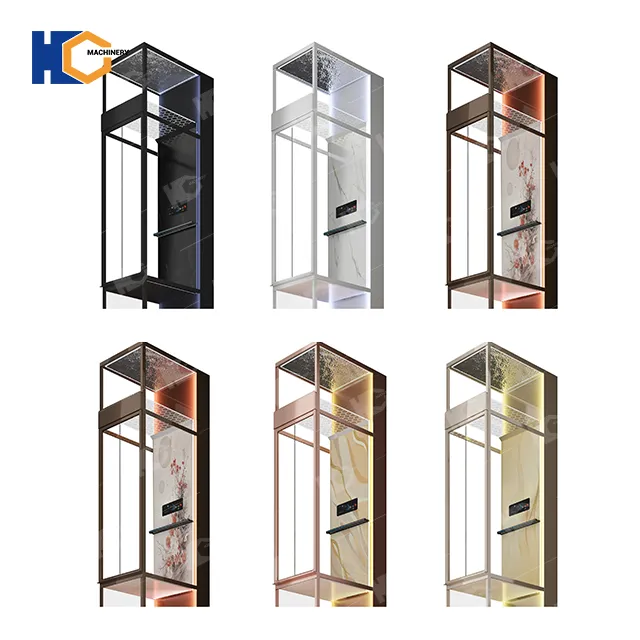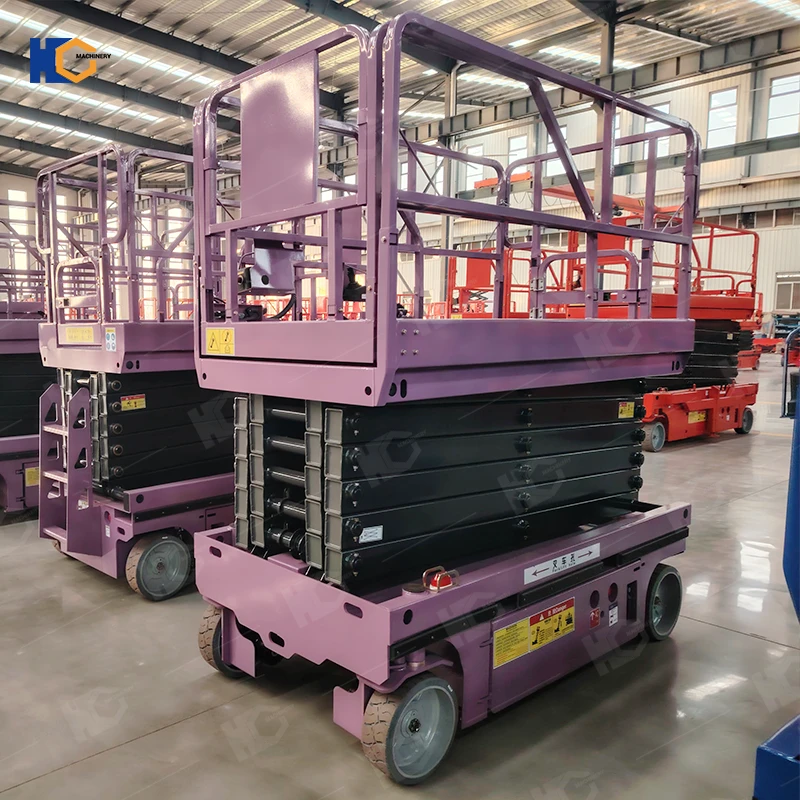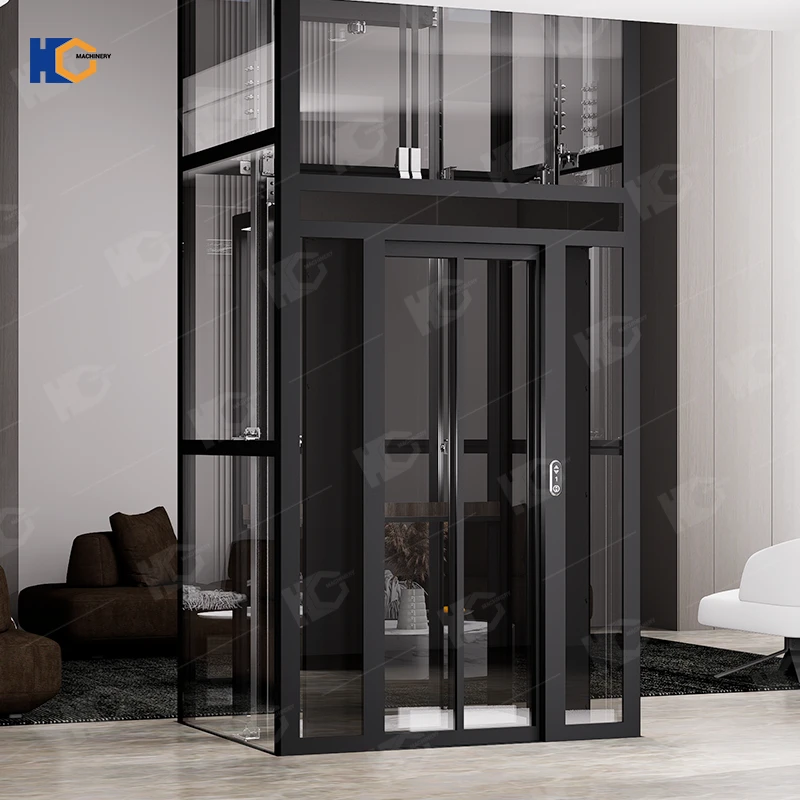When it comes to smooth, safe, and reliable vertical transportation, hydraulic elevators have been a proven solution for decades. Whether used in residential buildings, commercial offices, or industrial facilities, hydraulic elevator systems offer a combination of strength, simplicity, and cost efficiency.
This article explains everything you need to know — what a hydraulic elevator is, how it works, its major components, pros and cons, and how to choose the right model for your needs.
1. Understanding What a Hydraulic Elevator Is
A hydraulic elevator is a type of lift that moves by using fluid pressure generated by a pump. Instead of relying on counterweights or traction ropes (as in traction elevators), it operates through a piston (ram) inside a cylinder, powered by hydraulic oil.
When the elevator goes up, hydraulic fluid is pumped into the cylinder, pushing the piston and lifting the car. To descend, the system releases the fluid through a valve, allowing the elevator to move down smoothly under its own weight.
This technology is based on Pascal’s principle, where fluid pressure applied at one point in a closed system is transmitted equally throughout the fluid, resulting in efficient lifting power.
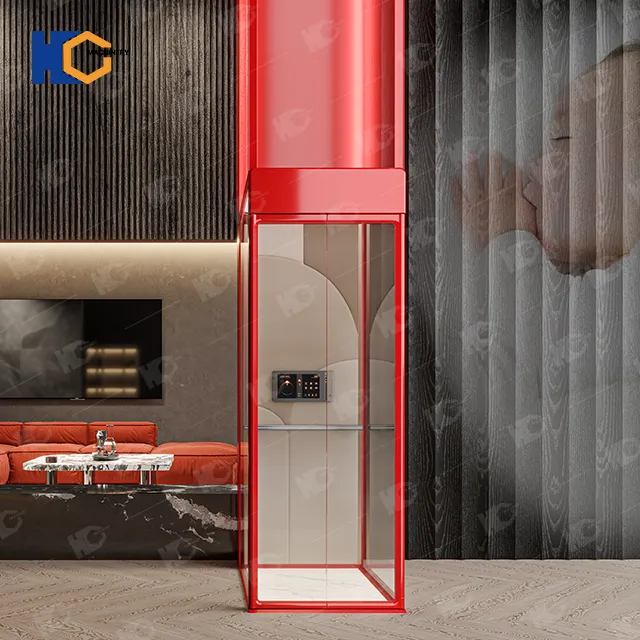
Home Hydraulic Lift Elevators in South Africa offer affordability and customization, with prices ranging from $10,000 to $20,000 (R190,000 to R375,000), depending on size, features, and design options.You can click the product introduction link: Home Hydraulic Lift Elevators in South Africa
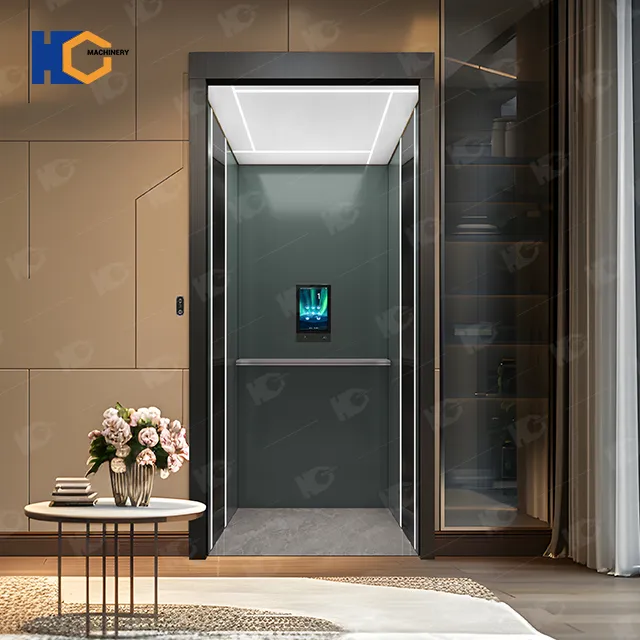
Investing in a Hydraulic Home Elevator is a practical and stylish solution for Nigerian homeowners looking to enhance their living experience. Our elevators combine cutting-edge technology, elegant design, and durability to deliver unparalleled performance and value. With competitive pricing, tailored solutions, and expert support, we are your trusted partner for home elevators in Nigeria. P Hydraulic home elevator in Nigeria
2. Main Components of a Hydraulic Elevator System
A hydraulic elevator system is a lift that uses liquid pressure (usually oil) to raise and lower the elevator car. Unlike traction elevators, which use cables and counterweights, hydraulic elevators operate through a piston and cylinder system powered by a hydraulic pump.
This design is especially suitable for buildings under 6–7 floors, including homes, offices, hospitals, factories, and shopping centers, due to its stability, cost-effectiveness, and low noise.
A typical hydraulic elevator system includes the following parts:
| Component | Description |
|---|---|
| Pump Unit | Generates pressure to move hydraulic fluid into the cylinder. |
| Cylinder and Piston (Ram) | The main lifting mechanism that pushes the elevator car upward. |
| Oil Tank (Reservoir) | Stores hydraulic oil for circulation. |
| Control Valve | Regulates oil flow for lifting and lowering operations. |
| Lift Car (Cabin) | The platform or enclosed car that carries passengers or goods. |
| Guide Rails | Ensure smooth, vertical movement of the lift car. |
| Controller and Electrical Panel | Manage signals between the car, pump, and safety systems. |
| Safety Devices | Include emergency lowering, over-speed protection, and door locks. |
The hydraulic elevator system is a proven, safe, and cost-effective vertical transportation solution.We've written a product article detailing this elevator hydraulic system. You can click here.
3. How Does a Hydraulic Elevator Work?
The working principle of a hydraulic elevator is both simple and effective:
Step 1: Lifting (Upward Movement)
When the Up button is pressed, the motor-driven pump forces hydraulic oil from the reservoir into the cylinder.
As the fluid fills the cylinder, it pushes the piston upward, raising the elevator car to the desired floor.
Sensors stop the pump once the car reaches the correct height.
Step 2: Lowering (Downward Movement)
To descend, the control valve releases oil slowly back into the tank.
The piston retracts, allowing the elevator car to lower smoothly under gravity.
The rate of descent is controlled by the valve to ensure safety and comfort.
Step 3: Emergency or Power Failure
Most hydraulic elevators are equipped with a manual lowering system or battery-powered descent to safely bring the car down to the nearest floor in case of power outage.
Understanding how Hydraulic Elevators work will give you a comprehensive understanding of how they operate. This will also help you understand the differences between Hydraulic Elevators and other elevators, and we've written an article about this topic: How Does a Hydraulic Elevator Work? A Complete Guide for Homeowners and Building Owners,If you are interested, you can read it carefully; it will be helpful to you.
4. Types of Hydraulic Elevators
Hydraulic elevators come in several configurations depending on installation space, building height, and usage purpose:
a) Conventional Hydraulic Elevator
Uses an underground cylinder and piston.
Suitable for 2–6 floor buildings.
Requires a hole below the pit to house the cylinder.
b) Holeless Hydraulic Elevator
No need for a deep hole; instead, it uses side-mounted pistons.
Ideal for existing buildings or sites where drilling is difficult.
Common in home elevators and low-rise offices.
c) Roped Hydraulic Elevator
Combines hydraulic power with steel ropes and a sheave (pulley) system.
Allows greater travel distance (up to 20 meters or 6–7 floors).
Used in mid-rise commercial buildings.
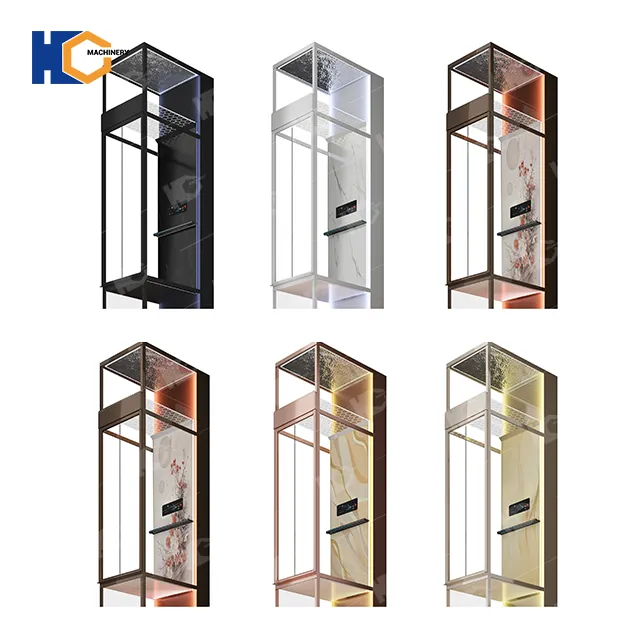
5. Advantages of Hydraulic Elevators
Hydraulic elevators offer multiple benefits that make them an attractive option for many applications:
1. Cost-Effective Installation
Hydraulic systems are generally cheaper to install compared to traction elevators. They don’t require overhead machinery or counterweights, reducing structural costs.
2. Space Saving
No overhead machine room is needed — only a small space for the power unit (pump and tank). This makes hydraulic elevators ideal for home and villa installations.
3. Smooth and Quiet Operation
Thanks to the hydraulic fluid’s damping effect, these elevators move smoothly and quietly, providing a comfortable ride experience.
4. Heavy Load Capacity
Hydraulic elevators can handle larger loads (from 300 kg to over 5000 kg), making them suitable for freight, car, or cargo lifting.
5. Safety and Reliability
Equipped with automatic lowering features and emergency stop valves, hydraulic elevators remain safe even during power failures.
6. Flexible Design
The compact system allows custom cabin sizes, finishes, and door configurations to match different architectural designs.
6. Disadvantages of Hydraulic Elevators
While efficient, hydraulic elevators also have limitations to consider:
| Limitation | Description |
|---|---|
| Speed | Typically slower (0.3–0.8 m/s) compared to traction elevators. |
| Height Restriction | Ideal for buildings up to 6–7 floors; not suitable for high-rises. |
| Oil Leakage | Improper maintenance may cause hydraulic oil leakage or odor. |
| Energy Use | More power is required when lifting the car upward. |
| Maintenance Cost | Regular oil replacement and inspection are necessary. |
Despite these, most users find hydraulic elevators more economical and easier to maintain for low-rise structures.
7. Common Applications
Hydraulic elevators are used across many industries and building types:
Residential Homes and Villas – for smooth, quiet, and safe movement between floors.
Commercial Buildings – low-rise offices, clinics, banks, and showrooms.
Industrial Facilities – transporting goods or workers between levels.
Hotels and Restaurants – providing accessibility and convenience.
Car Lifts and Parking Systems – moving vehicles in auto showrooms or parking towers.
Hospitals – patient bed lifts and medical equipment elevators.
8. Hydraulic Elevator vs. Traction Elevator
| Feature | Hydraulic Elevator | Traction Elevator |
|---|---|---|
| Lifting Mechanism | Piston and hydraulic fluid | Steel ropes and counterweight |
| Machine Room | Usually beside the shaft | Above the shaft |
| Speed | 0.3–0.8 m/s | Up to 2.5 m/s |
| Maximum Travel Height | Up to 6–7 floors | Up to 100+ floors |
| Energy Use | Higher when lifting | Energy-efficient with counterweight |
| Installation Cost | Lower | Higher |
| Maintenance | Simple | Complex |
| Noise Level | Very low | Moderate |
| Recommended For | Homes, low-rise, freight | High-rise commercial buildings |
If your project involves 2–6 floors, a hydraulic elevator is almost always the best choice in terms of cost, comfort, and practicality.
Hydraulic elevators and traction elevators are the most common types of home elevators. Many people may not be clear about the differences between the two, so we've written an article about it: Traction Elevator vs Hydraulic Elevator: What’s the Difference and How to Choose? By comparing Traction Elevator and Hydraulic Elevator, you can determine which type you prefer when choosing a home elevator. Then, visit the actual products to understand the performance and price of both types of elevators. Finally, you can purchase from the Huichuang Lift factory in China. As long as you describe your desired specifications in detail to the factory, you will definitely get the elevator with the best cost performance.
9. How to Choose the Right Hydraulic Elevator
Selecting a hydraulic elevator involves evaluating several factors:
1. Purpose of Use
Passenger elevators for homes or offices prioritize design and comfort.
Cargo or car elevators focus on lifting capacity and platform size.
2. Lifting Height and Speed
Standard hydraulic elevators travel up to 12–18 meters.
Choose roped hydraulic types if more travel is required.
3. Load Capacity
From 300 kg (residential) to 5000 kg (cargo) or more.
Always select a slightly higher capacity than your average load.
4. Installation Space
Verify shaft dimensions, pit depth, and overhead clearance.
For renovation or limited space, holeless systems are ideal.
5. Power and Control Options
Single-phase or three-phase motors depending on your building power supply.
Advanced models feature PLC or VVVF control for smoother operation.
6. Safety and Certification
Confirm compliance with EN81, ISO, or local elevator safety standards.
Look for emergency descent, safety locks, and overload protection.
7. After-Sales Support
Choose manufacturers or suppliers with local service teams or remote support capability.
10. Hydraulic Elevator Maintenance Guide
To ensure safety and long service life, hydraulic elevators must be maintained regularly. Here are essential maintenance steps:
Check Oil Level and Quality – Replace hydraulic oil every 1–2 years.
Inspect Valves and Seals – Prevent leakage and pressure loss.
Lubricate Guide Rails – Ensure smooth and quiet movement.
Test Safety Devices – Verify emergency stop, overload, and door sensors monthly.
Clean the Pit and Machine Room – Keep free of dust, oil residue, and water.
Professional Servicing – Have the system inspected by a certified technician at least twice a year.
Proper maintenance not only prevents breakdowns but also reduces energy consumption and extends equipment life.
11. Hydraulic Elevator Price Range (2025 Estimate)
Hydraulic elevator pricing varies by size, load capacity, and customization:
| Type | Capacity | Typical Price (USD) | Application |
|---|---|---|---|
| Home/Villa Hydraulic Elevator | 300–450 kg | $8,000 – $15,000 | 2–4 floors |
| Passenger Hydraulic Elevator | 450–1000 kg | $12,000 – $25,000 | Low-rise buildings |
| Cargo Hydraulic Elevator | 1000–5000 kg | $15,000 – $35,000 | Warehouses, factories |
| Car Hydraulic Lift | 3000–6000 kg | $20,000 – $40,000 | Auto showrooms, garages |
(Prices include basic cabin, controller, and installation but vary depending on brand, customization, and location.)
12. Future Trends in Hydraulic Elevator Technology
Modern hydraulic elevators are evolving rapidly with smart control systems and energy-efficient designs:
Eco-friendly hydraulic oil with low viscosity and recyclability.
Regenerative drives to reduce power consumption.
IoT monitoring systems for remote diagnostics and predictive maintenance.
Compact pump units to reduce noise and space usage.
Integrated design flexibility for modern home aesthetics.
These innovations make hydraulic elevators more efficient, user-friendly, and environmentally sustainable than ever before.
13. Conclusion
A hydraulic elevator is a proven, reliable, and cost-effective lifting solution for low- to mid-rise buildings. Its simple structure, quiet operation, and flexible installation options make it ideal for homes, offices, and industrial applications alike.
When choosing a hydraulic elevator, always consider:
The building height and purpose
The required load capacity
Available installation space and power supply
The manufacturer’s safety standards and after-sales support
Whether for home comfort, passenger convenience, or industrial lifting, a high-quality hydraulic elevator delivers smooth, safe, and long-lasting vertical transport performance.
